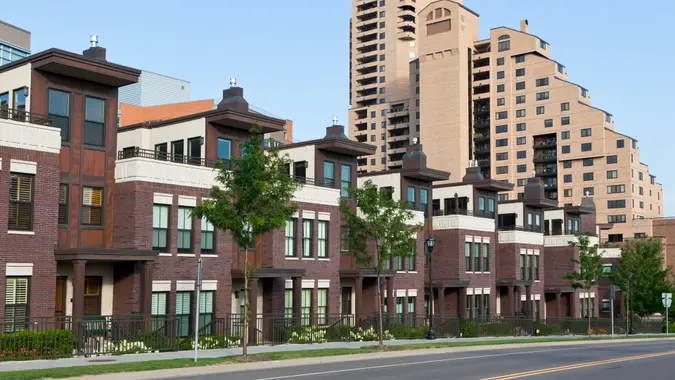Here’s How Much the Definition of Middle Class Has Changed in the Midwest

Commitment to Our Readers
GOBankingRates' editorial team is committed to bringing you unbiased reviews and information. We use data-driven methodologies to evaluate financial products and services - our reviews and ratings are not influenced by advertisers. You can read more about our editorial guidelines and our products and services review methodology.

20 Years
Helping You Live Richer

Reviewed
by Experts

Trusted by
Millions of Readers
In many cases, the definition of middle class remains somewhat subjective in the eyes of the paycheck holders. However, this notion of income-defining status is on that is deeply rooted in the American identity.
To fulfill the promise of the capitalistic dream, in an ideal world mobility would be upward, the economy would be stable and opportunities would be abundant.
However, in recent years, especially in the Midwest, that definition has shifted dramatically from what was once considered the heart and driving force of American prosperity.
The post-World War II economic boom fostered a strong manufacturing sector, where steady, well-paying jobs allowed families to buy homes, send their children to college and save for retirement. Incomes in the Midwest were often sufficient to sustain a comfortable lifestyle in places like Detroit, Milwaukee and Cleveland, where housing costs were relatively low compared to coastal cities.
GOBankingRates recently conducted a study to discover just how much the definition of “middle class” has changed throughout the United States. Specifically, here is how much that definition has changed in the 12 states considered to be Midwestern.
You can also find out how much the definition of middle class changed in the New England region.
Is the Middle Class Shrinking in The Midwest?
Over the past few decades, several economic pressures have eroded the stability of the Midwest’s middle class.
The decline of manufacturing jobs due to globalization, automation and outsourcing has left many without the steady employment that once sustained the region.
This shift has produced an expanding range of income that includes the middle class, but fewer people not living paycheck to paycheck.
North Dakota
- 2022 middle-class income range: $49,306 to $147,918
- 2012 middle-class income range: $34,427 to $103,282
- 10-year change in middle-class income: 43.2%
Minnesota
- 2022 middle-class income range: $56,209 to $168,626
- 2012 middle-class income range: $39,417 to $118,252
- 10-year change in middle-class income: 42.6%
South Dakota
- 2022 middle-class income range: $46,305 to $138,914
- 2012 middle-class income range: $32,727 to $98,182
- 10-year change in middle-class income: 41.5%
Michigan
- 2022 middle-class income range: $45,670 to $137,010
- 2012 middle-class income range: $32,314 to $96,942
- 10-year change in middle-class income: 41.3%
Middle-Class Income vs. Midwestern Prices
Incomes have become more polarized throughout the country, with high-income earners capturing more of the nation’s wealth, while those in the middle class face increasing financial insecurity.
The gap between rural and urban areas in the Midwest also plays a significant role, and rural parts of the Midwest continue to struggle with job losses and population decline, leading to a wider disparity in what constitutes middle-class living depending on where one lives such as in the following states:
Kansas
- 2022 middle-class income range: $46,498 to $139,494
- 2012 middle-class income range: $34,182 to $102,546
- 10-year change in middle-class income: 36%
Nebraska
- 2022 middle-class income range: $47,815 to $143,444
- 2012 middle-class income range: $34,254 to $102,762
- 10-year change in middle-class income: 39.6%
Iowa
- 2022 middle-class income range: $47,047 to $141,142
- 2012 middle-class income range: $34,086 to $102,258
- 10-year change in middle-class income: 38%
Missouri
- 2022 middle-class income range: $43,947 to $131,840
- 2012 middle-class income range: $31,555 to $94,666
- 10-year change in middle-class income: 39.3%
The New Midwestern Middle Class
To survive economic shifts, everyone has to evolve and adapt, and Midwesterners are no exception.
New industries, such as renewable energy, advanced manufacturing and healthcare, could offer hope for economic revitalization in the region. Many Midwestern cities are investing in infrastructure, education and innovation to attract new businesses and create opportunities for a modern middle class.
Indiana
- 2022 middle-class income range: $44,782 to $134,346
- 2012 middle-class income range: $32,249 to $96,748
- 10-year change in middle-class income: 38.9%
Ohio
- 2022 middle-class income range: $44,660 to $133,980
- 2012 middle-class income range: $32,164 to $96,492
- 10-year change in middle-class income: 38.9%
Illinois
- 2022 middle-class income range: $52,289 to $156,866
- 2012 middle-class income range: $37,902 to $113,706
- 10-year change in middle-class income: 38%
Wisconsin
- 2022 middle-class income range: $48,305 to $144,916
- 2012 middle-class income range: $35,085 to $105,254
- 10-year change in middle-class income: 37.7%
Final Take To GO
The bottom line is that the middle class in the Midwest has undergone a significant transformation over the past few decades. What was once defined by stable manufacturing jobs and affordable living now grapples with economic volatility.
As the region continues to evolve, so too will the definition of the middle class as well as adaptations that must be made to maintain that status.
Methodology: For this piece, GOBankingRates first sourced the 2012, 2017 and 2022 household median income of every state, as sourced from the 2012, 2017 and 2022 American Community Surveys as conducted by the U.S. Census Bureau. With these median household incomes isolated, GOBankingRates was able to find middle-class income ranges for each respective year with the following definition: those with an annual household income that was two-thirds to double the national median income. For each state, GOBaningRates found 2022 middle-class income range, 2017 middle-class income range, 2012 middle-class income range, 10-year change in middle-class income range, and 10-year percent change in middle-class income. All data was collected and up to date as of Apr. 8, 2024.
More From GOBankingRates
- Nearly 1 in 3 Americans Hit by a Costly Holiday Scam, Norton Survey Shows -- How To Avoid This
- Here's What Retirees Wasted the Most Money On in 2025 -- and How To Avoid It in 2026
- How Middle-Class Earners Are Quietly Becoming Millionaires -- and How You Can, Too
- 6 Safe Accounts Proven to Grow Your Money Up to 13x Faster
 Written by
Written by  Edited by
Edited by 

























